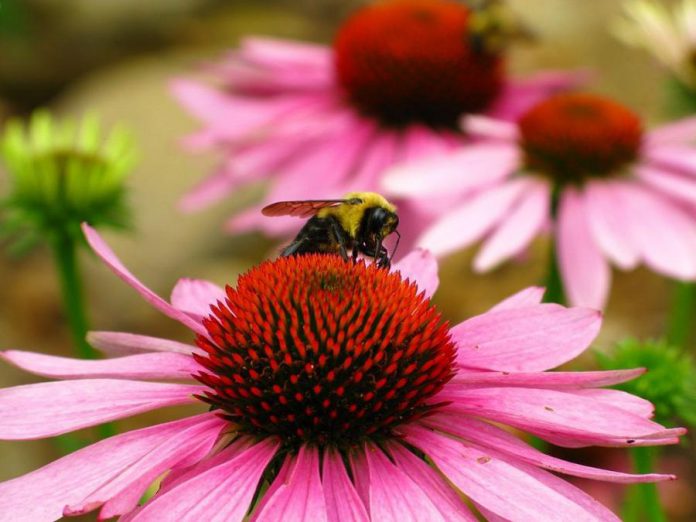
While doing some pruning around the house over the weekend, I discovered that bumblebees have made an interior wall of the garage their home. Over the winter, squirrels chewed a hole through an exterior wall, making a space just big enough for themselves — and now the bees — to enter.
No question the bees are a nuisance, and I could go as far to remove them with pesticides. However, this action would potentially kill hundreds of bees in one foul swoop. Given all the alarming stories we’ve been hearing about the sharp decline in the bee population, I’ve decided to leave them be (pardon the pun) for now.
Bees are vitally important to our food system. They pollinate crops and fruit and nut trees, ensuring we have an adequate supply of food. If we see big declines in our bee population, we could face food shortages and see the price of food skyrocket.
Bees are mostly commonly seen flitting from flower to flower in backyard gardens. These very gardens, if they contain plants purchased from many large retail garden centres, could in fact be killing or harming the bees that visit them.
A new study recently released by Friends of the Earth Canada shows that over half of “bee-friendly” plants sold at garden centres have been pre-treated with neonicotinoid (neonics) pesticides shown to harm and kill bees.
The Canadian data is part of a larger study that was released by Friends of the Earth Canada and Friends of the Earth U.S. with Pesticide Research Institute.
Garden plant samples were collected from garden retailers from 18 cities across Canada and the United States. Canadian samples were collected in London, Montreal, and Vancouver.
The report found that 51 per cent of the total samples contain the bee-killing neonicotinoids. Some flowers contained neonic levels high enough to kill bees outright, assuming comparable concentrations are present in the flowers’ pollen and nectar.
“Most gardeners have no idea their gardens may be harmful to bees,” says Beatrice Olivastri, Friends of the Earth CEO, in a news release.
The group is circulating a petition that calls on retailers to remove plants treated with neonicotinoids from their supply chain as soon as possible. Outside of North America, the majority of the UK’s largest garden retailers have already voluntarily stopped selling garden products containing neonics, according to the release.
Another negative implication of having the neonics applied to plants sold at many commercial garden centres is that the pesticdes don’t break down quickly, according to report co-author Timothy Brown.
“These flowers could be toxic to bees for years to come,” Brown says.
You can view the full report and sign the petition at www.foecanada.org.
What can you do to help prevent bees from ingesting these lethal chemicals? Buy organically grown plants, or purchase your plants from a nursery or other retailer that doesn’t treat their nursery stock with pesticides. Plants purchased from GreenUP Ecology Park are free of pesticides and thrive in our climate.
Another great step is to make your backyard bee friendly. Research plants that bees and other pollinators are attracted to and add a pollinator garden.
The key to a pollinator garden is to use as many native plant species as possible. These plants have evolved closely with our native insects (including bees) and are well-suited to meet their needs. When choosing plants, look for older varieties, avoiding double blossoms or hybrids, which may look attractive but sometimes lack accessible nectar or pollen for insects or other animals.
We need to start thinking beyond bumblebees. According to the David Suzuki Foundation, Canada is home to hundreds of species of bees that come in all shapes in sizes. Some of these species live above ground and some live below, but all need our help.
Trumpet or cup-shaped flowers such as cardinal flower, honeysuckle, and bee balm, attract a wide range of bees and other pollinators. Those with shorter tongues, such as small native bees and wasps, feed on tightly packed clusters of small flowers, such as those found on milkweed, zinnia, or phlox.
Plants aside, you can also create homemade nesting sites suitable for pollinators like bees. Bee nesting blocks can be made out of an untreated wood block by drilling a number of holes approximately 1/4 to 3/8″ inches in diameter, and four to six inches deep. Mount the block on a post or the side of a building.


























